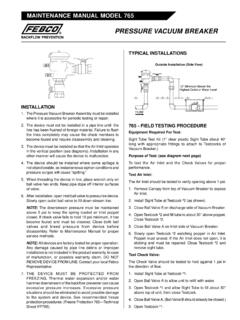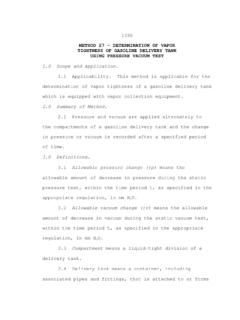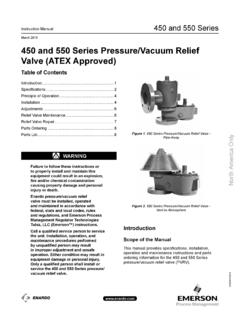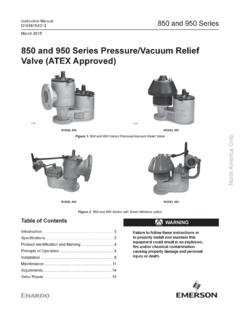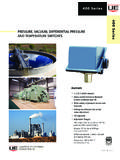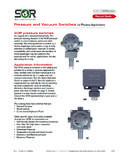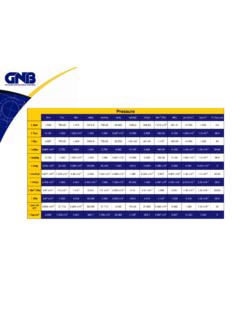Transcription of PVB4A Series - SPRINKLER TALK
1 BFMMPVB4A 5/09 PVB4A SeriesInstallation, Operation, and Maintenance Manual pressure vacuum Breaker (PVB) Backflow Preventers 1/2 2 Conbraco Industries Inc. Box 247 Matthews, North Carolina 28106 Customer Service: 704-841-6000 Fax: 704-841-6020 TABLE OF CONTENTS pressure Type vacuum Breaker 1/2 2 Section Page I. Description and 2 II. 2 III. Trouble Shooting 3 IV. Maintenance Instructions 1/2 2 .. 3 V. Testing Procedure 1/2 2 .. 4 - 5 VI. Parts List 1/2 2 ..6 8 VII. Repair Kits 1/2 2 ..8 1 The Apollo PVB4A Series pressure Type vacuum Breaker consists of a replaceable check valve cartridge and a unique one-piece atmospheric vent bonnet/float assembly located between two resilient seated shut-off valves.
2 The modular design allows for unprecedented ease of inspection and maintenance. During normal flow conditions, the check valve remains open and the float seals on the bonnet assembly. A minimum supply pressure of 10 psig is normally required to fully shut the float. As the line pressure falls to 1 psig, a spring-loaded atmospheric vent valve opens, breaking the vacuum and thereby preventing back-siphonage. In the event of exposure to short-term freezing temperatures, a spring-loaded relief valve in the float protects the PVB body and internal components from damage. As the temperature increases above freezing, the relief valve automatically reseats. During normal operating conditions, the relief valve will not discharge.
3 NOTE: The freeze resistant feature is for a short-term dip in temperature. The PVB should be winterized for extended periods below freezing. I. DESCRIPTION AND OPERATION II. INSTALLATION pressure vacuum breaker assembly s critical level (CL is marked in raised lettering on the body of the PVB) should be installed at least 12 inches above the highest piping or outlet downstream of the device and with the supply line connected to the bottom of the device. Install the device in an accessible location to facilitate periodic field-testing and any required maintenance. Contact local water authorities for installation/service requirements. Flush upstream piping thoroughly to remove foreign matter prior to installation. Use pipe dope sparingly on external threads only.
4 When initially pressurizing the device, some spillage of water from the air inlet may occur. To winterize the valve: 1. Secure the water source at a location that will not freeze. 2. Open #1 and #2 test cocks to drain the PVB. 3. Place the inlet and outlet isolation ball valves in the halfway open/shut position. 4. If possible, blow the lines clear with pressurized air. FIGURE 1 FIGURE 2 (NO FLOW CONDITION) (FLOWING CONDITION) 2 III. TROUBLE SHOOTING GUIDE SYMPTOM CAUSE CORRECTIVE ACTION 1. Air inlet fails to open or opens below 1 psig. a. Float not moving freely.
5 B. Float disc sticking to seat. a. Inspect for fouling debris or deposits. b. Clean float seat area on bonnet and replace float disc/turn disc over. 2. Air inlet fails to close. a. Float not moving freely. b. Float disc fouled with debris. a. Inspect for fouling debris or deposits. b. Clean float seat area on bonnet and remove debris. 3. Check valve fails to hold 1 psig. a. Check valve fouled with debris. b. Check valve seat damage. a. Remove, clean, or replace check valve. b. Replace seat. 4. Water continues to flow from test cock #2 during test #2. a. #1 shut-off valve not completely closed a. Close #1 shut-off valve. B.
6 Assembly 1. If the check seat was removed, install the new o-ring and lubricate with Apollo supplied lubricant, DOW 111, or equal. Line up the seat with the bore and push it firmly into place. 2. Install new disc in poppet and secure with washer and screw. 3. Place and center the poppet assembly in the check seat. 4. Install the spring onto the poppet, ensure that it is centered around the raised spring pad. 5. Install the spring retainer onto the spring by pushing down into the grooves of the check seat and turning 90 degrees. Ensure spring retainer pops up about .1 and locks into the lugs. CAUTION: Ensure the spring retainer orientation matches that in the parts list drawing or the device s flow will be significantly restricted.
7 6. Install float cage and float. See drawing for correct orientation. 7. Apply a thin coat of Apollo supplied lubricant, DOW 111, or equal onto o-ring, screw bonnet into body. 8. Test device to insure proper installation. 9. Install air inlet canopy. 3 IV. MAINTENANCE INSTRUCTIONS 1/2 2 A. Disassembly 1. Close #2 shut-off valve, then close #1 shut-off valve. 2. Bleed pressure from device by opening test cocks #1 and #2. 3. Remove the air inlet canopy by loosening the two screws, rotating the canopy to the left, and lifting up. 4. Unscrew and remove the bonnet and float assembly. DO NOT USE CANOPY TO UNSCREW BONNET! DAMAGE TO THE CANOPY MAY OCCUR. 5. Remove float cage. 6. Push down and turn the spring retainer 90 degrees to remove.
8 Remove the spring. Remove the poppet from the check seat. CAUTION: Do not use pliers or other tools, which may damage or scratch the plastic stem. 7. Holding the poppet assembly in one hand, remove screw and retaining washer. 8. Remove the seat disc. 9. All parts should be carefully inspected for any damage or excessive wear and thoroughly rinsed in clean water prior to reassembly. Replace worn parts as necessary. 10. Normally, the check seat need not be removed. If removal is required, rock it back and forth while pulling outward. V. TESTING PROCEDURES Equipment Required: Differential pressure Test Kits 40-200-TKU or 40-200-TK5U. NOTE: These procedures and may or may not be approved in all jurisdictions.
9 Consult your local water purveyor for acceptable test procedures. Test Setup 1. Obtain permission to shut off the water supply. 2. Determine the direction of flow. 3. Identify and blow out test cocks and install appropriate adapters. 4. All test kit valves are closed. IMPORTANT: THE TEST KIT AND HOSE MUST BE HELD AT THE SAME LEVEL AS THE PVB DURING TESTS 1 AND 2. TEST #1 DOES THE AIR INLET VALVE OPEN WHEN THE pressure IN THE BODY IS AT LEAST 1 PSI ABOVE ATMOSPHERIC pressure ? IS THE AIR INLET VALVE FULLY OPEN WHEN WATER DRAINS FROM THE BODY? 1. Remove air inlet valve canopy. 2. Connect a hose between test cock #2 and the high side connection on the test kit. Open test cock #2. 3. Bleed the high side by opening bleed high valve (high and bypass valves on a 3-valve test kit).
10 Close the bleed high valve (high valve on a 3-valve test kit). 4. Close #2 shut off valve, and then close #1 shut off valve. 5. SLOWLY open the bleed high valve (high valve on a 3-valve test kit) no more than 1/4 turn, dropping the pressure slowly. Record pressure reading when the air inlet valve opens. It should be 1 PSI or higher. If the air inlet valve does not open go to step #8. 6. Fully open the bleed high valve (high valve on a 3-valve test kit). Check if the air inlet valve is fully open. Close the bleed high valve (high valve on a 3-valve test kit). 7. Close test cock #2. Disconnect the high hose from test cock #2. Open shut off valve #1. Proceed to Test #2. 8. The #1 shut off valve is leaking. Open and close shut off valve #1 to attempt a better seal.

